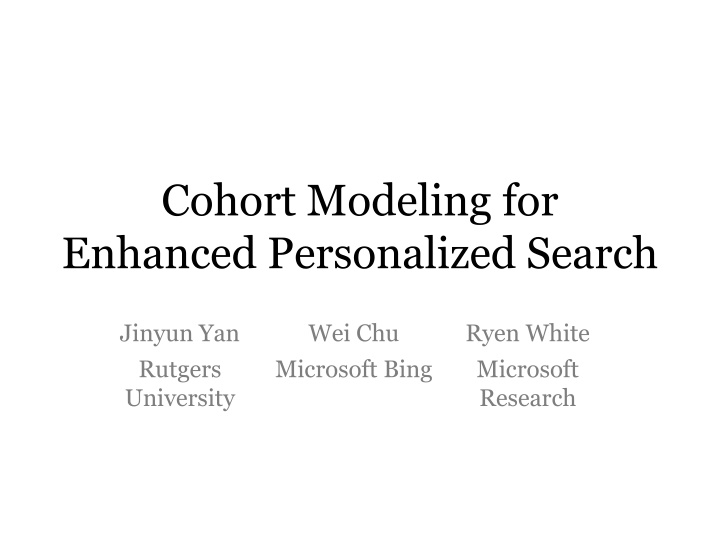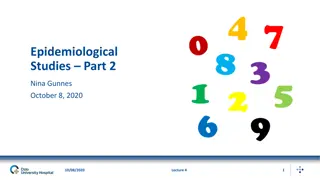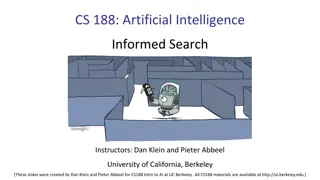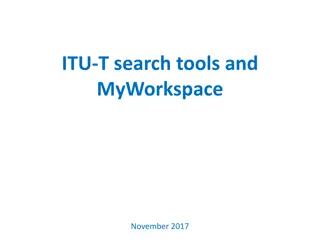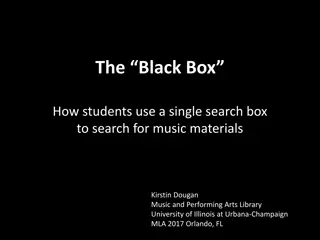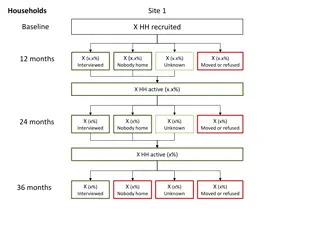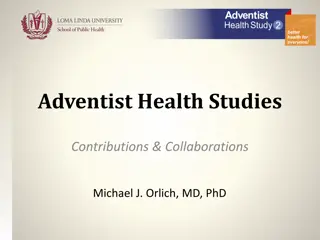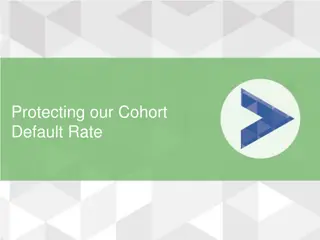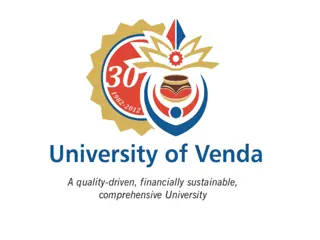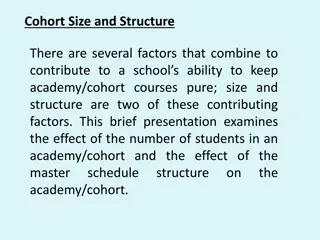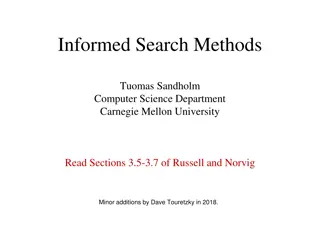Enhancing Personalized Search with Cohort Modeling
Personalized search faces challenges due to the reliance on personal history, leading to a cold start problem. Cohort modeling offers a solution by grouping users with shared characteristics to improve search relevance. By leveraging cohort search history and collaboration, this approach aims to enhance the user experience in personalized search.
Uploaded on Oct 11, 2024 | 1 Views
Download Presentation

Please find below an Image/Link to download the presentation.
The content on the website is provided AS IS for your information and personal use only. It may not be sold, licensed, or shared on other websites without obtaining consent from the author.If you encounter any issues during the download, it is possible that the publisher has removed the file from their server.
You are allowed to download the files provided on this website for personal or commercial use, subject to the condition that they are used lawfully. All files are the property of their respective owners.
The content on the website is provided AS IS for your information and personal use only. It may not be sold, licensed, or shared on other websites without obtaining consent from the author.
E N D
Presentation Transcript
Cohort Modeling for Enhanced Personalized Search Jinyun Yan Rutgers University Wei Chu Microsoft Bing Ryen White Microsoft Research
Personalized Search Many queries have multiple intents e.g., [H2O] can be a beauty product, wireless, water, movie, band, etc. Personalized search Combines relevance and the searcher s intent Relevant to the user s interpretation of query
Challenge Existing personalized search Relies on the access to personal history Queries, clicked URLs, locations, etc. Re-finding common, but not common enough Approx. 1/3 of queries are repeats from same user [Teevan et al 2007, Dou et al 2007] Similar statistics for <user, q, doc> [Shen et al 2012] 2/3 queries new in 2 mo. - cold start problem
Motivation for Cohorts When encountering new query by a user Turn to other people who submitted the query e.g., Utilize global clicks Drawback No personalization Cohorts A group of users similar along 1+ dimensions, likely to share search interests or intent Provide useful cohort search history
Situating Cohorts Global Individual Cohort Not personalized Hard to Handle New Queries Hard to Handle New Documents Sparseness (Low Coverage) Conjoint Analysis Learning across Users Collaborative Grouping/Clustering Cohorts
Related Work Explicit groups/cohorts Company employees [Smyth 2007] Collaborative search tools [Morris & Horvitz 2007] Implicit cohorts Behavior based, k-nearest neighbors [Dou et al. 2007] Task-based / trait-based groups [Teevan et al. 2009] Drawbacks Costly to collect or small n Uses information unavailable to search engines Some offer little relevance gain
Problem Given search logs with <user, query, clicks>, can we design a cohort model that can improve the relevance of personalized search results?
Concepts Cohort: A cohort is a group of users with shared characteristics E.g., a sports fan Cohort cohesion: A cohort has cohesive search and click preferences E.g., search [fifa] click fifa.com Cohort membership: A user may belong to multiple cohorts Both a sports fan and a video game fan
Our Solution Identify particular cohorts of interest Cohort Generation Cohort Membership Find people who are part of this cohort Mine cohort search behavior (clicks for queries) Cohort Behavior Identify cohort click preferences Cohort Preference Build models of cohort click preferences Cohort Model Apply that cohort model to build richer representation of searchers individual preferences User Preference
Cohort Generation Proxies Location (U.S. state) Topical interests (Top-level categories in Open Directory Project) Domain preference (Top-level domain, e.g., .edu, .com, .gov) Inferred from search engine logs Reverse IP address to estimate location Queries and clicked URLs to estimate search topic interest and domain preference for each user
Cohort Membership Multinomial distribution Smoothed ????????? ?,?? + 1 ?????????? ?,?? + ? ? ??? = ? ?,?? = Smoothing parameter Example: ? = [Arts, Business, Computers, Games] SATClicks = [0, 1, 2, 5] (clicks w/ dwell 30s) ?(?,?) = [0.083, 0.167, 0.25, 0.5 ]
Cohort Preference Query q Cohort click preference Cohort CTR: d1 ?????????? ?,?,? ?(?,??) ????????????(?,?,?) ?(?,??) ??? ?,?,?? = Global CTR: ?????????? ?,? ????????????(?,?) ??? ?,? = d2 Simplified example: Global preference: 4 3 ??? ?1,? ,??? ?2,? Cohort preference = 100, 100 ? Cohort 1: ?????1,?1,? ,?????1,?2,? = ???,0 ? Cohort 2: ?????2,?1,? ,?????2,?2,? = 0, ???
Cohort Model Estimate individual click preference by cohort preference ? ?,?,?,?? = ? ?,?,?? ? ??? = ???(?,?,??) ?(?,??) Cohort features Re-rank Machine -learned model Personalized Ranking Search results Personal features Universal rank Ranked List
Experiments Setup Randomly sampled 3% of users 2-month search history for cohort profiling: cohort membership, cohort CTR 1 week for evaluation: 3 days training, 2 days validation, 2 days testing 5,352,460 query impressions in testing Baseline Personalized ranker used in production on Bing With global CTR, and personal model
Experiments Evaluation metric: Mean Reciprocal Rank of first SAT click (MRR)* MRR = MRR(cohort model) MRR(baseline) Labels: Implicit, users satisfied clicks Clicks w/ dwell 30 secs or last click in session 1 if SAT click, 0 otherwise * MAP was also tried. Similar patterns to MRR.
Results Cohort-enhanced model beats baseline Group Type ODP (Topic interest) TLD (Top level domain) Location (State) ALL (ODP + TLD + Location) 0.0211 0.00146 MRR SEM 0.0187 0.00143 0.0229 0.00145 0.0113 0.00142 Re-Ranked@1 0.91% 0.96% 0.90% 0.98% Positive MRR gain over personalized baseline Average over many queries, with many MRR = 0 Gains are highly significant (p < 0.001) ALL has lower performance, could be noisier: Re-ranks more often, Combining different signals
Performance on Query Sets New queries Unseen queries in training/validation 2 MRR gain vs. all queries Queries with high click-entropy ???????????? ? = ???(?,?) log(??? ?,? ) ? 5 MRR gain vs. all queries Ambiguous queries 10k acronym queries, all w/ multiple meanings 10 MRR gain vs. all queries
Cohort Generation: Learned Cohorts Thus far: Pre-defined cohorts Manual control of cohort granularity Next: Automatically learn cohorts User profile <location, search interests, domain preference> Cluster users into cohorts: ?-means Cohort membership: Soft cluster membership Distance between user vector and cohort vector exp ?(??,??)2 ?2 ? ?,?? = ? ??? = exp ?(??,??)2 ? ?=1 Simplified version of Gaussian mixture model w/ identity covariance ?2
Finding Best K Baseline: Predefined cohorts (from earlier) Focus on different query sets e.g., those with higher click entropy Probed ? = 5, 10, 30, 50, 70 Learned (for one set) Top gain at ?=10, sig Future work: Need more exploration of results at 5 < ? < 30 Learned cohort vs. pre-defined cohort (at diff K) 0.14 0.12 0.1 MRR Gain 0.08 0.06 0.04 0.02 0 5 10 30 K pre-defined group 50 70 clustered group
Summary Cohort model enhanced personalized search Enrich models of individual intent using cohorts Automatically learn cohorts from user behavior Future work: More experiments, e.g., parameter sweeps More cohorts: Age, gender, domain expertise, political affiliation, etc. More queries: Long-tail queries, task-based and fuzzy matching rather than exact match
Thanks Questions?
